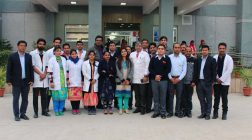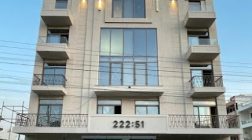Maharashtra Needs Better Healthcare Administrators nor Policies for implementing programs!
Maharashtra Needs Better Healthcare Administrators nor Policies for implementing programs!.The state of Healthcare is in a pitiable conditions in the rural areas due to the ineffective state administrators & lack of effective policy implementations. Where there are no dearth of money but critical condition is that of lack of will & political leadership.
“The Bombay high court has granted interim relief to the contractual doctors in view of the absence of medical care at state’s anganwadis and ordered the state government to reinstate the terminated doctors recruited under the scheme. The state government so far has not followed the orders. They are now going to appeal in the Supreme Court,” said a medical officer under RBSK.

About 19 lakh children up to 18 years in Pune district are scheduled to undergo medical screening in 2014.
“It means that we need to screen 2.5 lakh children every month. We have been out of jobs since July. Around 5 lakh children in Pune district have not been screened and they are being deprived of their right to good health and medical care. There are total 124 medical officer recruited under RBSK in Pune district, who have not been reinstated despite the court’s orders,” said another medical officer under RBSK.
In addition, 36 children in Pune district, who have been identified with serious heart ailments like congenital heart diseases, ventricular septal defect (hole in heart), rheumatic heart disease could not go through surgeries as the medical officers at designated private and government hospitals are yet to be reinstated.
“Of the 36 children, two suffer from a rare heart condition like tetralogy of fallot, which is caused by a combination of four heart defects that are present at birth. The condition of these children can turn any time if they are not immediately operated upon,” said a doctor.
S S Sathe, civil surgeon of Civil Hospital, Pune said, “It is true that the Bombay high court has asked the state to reinstate the terminated doctors early this month. They have not been called back to active duty as we are seeking guidelines from the officials of National Rural Health Mission under which the RBSK programme is implemented.”
A total of 2,150 contractual medical officers in the state provide medical screening and treatment to children below 18 years of age under the government’s child health programme.
The state had terminated services of 660 medical officers for supporting the recent strike called by the Maharashtra Association of Gazetted Medical Officers (MAGMO).
The government argued that the doctors’ decision to join the strike was a violation of contract, which clearly states that doctors under RBSK cannot strike work. Around 438 doctors under RBSK later challenged the termination in two separate petitions.
“The court has suspended the state government’s termination orders issued to BAMS doctors recruited under RBSK and directed the state government to allow them to report to work. The court also directed the state government not to go ahead with the appointments of freshly recruited staff selected through the recent advertisement,” said the advocate, who is fighting the case on behalf of the RBSK doctors.
The court in its order on August 7 observed that Maharashtra Association of Gazetted Medical Officers (MAGMO) had called the strike and the doctors under RBSK were pressurized to participate in the strike. The court also observed that the doctors work in difficult conditions on paltry remuneration and hence called their termination, harsh.
The first petition was filed by an advocate, who was also a doctor, challenging the strike called by MAGMO. The state government then decided to set up a committee to look into issues that compel doctors to go on strike and the court supported it.
The second petition was filed by BAMS doctors from Pune district and third petition was filed by doctors from others districts. Both the petitions challenged termination of doctors recruited by state government under RBSK.
Despite repeated attempts, Sujata Sounik, principal secretary (health) could not be contacted.
The issue
Nearly 2,150 contractual medical officers in the state provide medical screening and treatment to children below 18 years under the Rashtriya Bal Swasthya Karyakram
The state had terminated services of 660 medical officers for supporting the strike called by the Maharashtra Association of Gazetted Medical Officers
The government argued that the doctors’ decision to join the strike was a violation of their contract
Around 438 doctors challenged the termination in two separate petitions
The Bombay high court granted interim relief to the contractual doctors in view of the absence of medical care at state’s anganwadis and ordered the government to reinstate the terminated doctors
The state government’s delay in reinstating the contractual medical officers has deprived five lakh children from Pune district’s anganwadis, government and private schools of medical screening under the Rashtriya Bal Swasthy Karyakram (RBSK). As many as 36 children with serious heart defects are still waiting for surgeries.
About five lakh children from Pune district’s anganwadis and government and private schools have been deprived of medical screening under the Rashtriya Bal Swasthy Karyakram (RBSK). Besides, 36 children identified with serious heart defects in Pune district in March are still waiting to undergo life saving cardiac surgeries.
The medical officers have not been taken back despite clear directions by the Bombay High Court to take them back.
| No | Main objectives of the health programs |
| 1 | To provide adequate and qualitative preventive and curative health care to the people of the State. |
| 2 | To ensure greater access to primary health care by bringing medical institutions as close to the people as possible or through mobile health units, particularly in the under-served and backward districts. |
| 3 | To improve maternal and child health with a view to reducing maternal and infant mortality. |
| 4 | To improve hospital services at the secondary levels both in terms of infrastructure and personnel. |
| 5 | To give training to doctors, nurses and other paramedical staff to meet the needs of health care in the State by upgrading their skills and knowledge. |
| 6 | To improve the maintenance of buildings |
| 7 | To implement various national health programmes |
| 8 | To give health education for improving knowledge, attitude and behaviour of the community. |
The Total Fertility Rate of the State is 1.9. The Infant Mortality Rate is 28 and Maternal Mortality Ratio is 104 (SRS 2007 – 2009) which are lower than the National average. The Sex Ratio in the State is 925 (as compared to 940 for the country). Comparative figures of major health and demographic indicators are as follows :
Table I: Demographic, Socio-economic and Health profile of Maharashtra State as compared to India figures
| Indicator | Maharashtra | India |
|---|---|---|
| Total Population (In crore) (Census 2011) | 11.2 | 121.01 |
| Decadal Growth (%) (Census 2011) | 15.99 | 17.64 |
| Infant Mortality Rate (SRS 2011) | 25 | 44 |
| Maternal Mortality Rate (SRS 2007-09) | 104 | 212 |
| Total Fertility Rate (SRS 2011) | 1.9 | 2.4 |
| Crude Birth Rate ( SRS 2011) | 16.7 | 21.8 |
| Crude Death Rate ( SRS 20101) | 6.3 | 7.1 |
| Natural Growth Rate (SRS 2011) | 10.3 | 14.7 |
| Sex Ratio (Census 2011) | 925 | 940 |
| Child Sex Ratio (Census 2011) | 883 | 914 |
| Schedule Caste population (In crore) (Census 2001) | 0.98 | 16.6 |
| Schedule Tribe population (In crore) (Census 2001) | 0.85 | 8.4 |
| Total Literacy Rate (%) (Census 2001) | 82.91 | 74.04 |
| Male Literacy Rate (%) (Census 2001) | 89.82 | 82.14 |
| Female Literacy Rate (%) (Census 2001) | 75.48 | 65.46 |
Table II: Health Infrastructure of Maharashtra
| Particulars | Required | In position | shortfall |
|---|---|---|---|
| Sub-centre | 13410 | 10580 | 2830 |
| Primary Health Centre | 2189 | 1811 | 378 |
| Community Health Centre | 547 | 363 | 184 |
| Health worker (Female)/ANM at Sub Centres & PHCs | 12391 | 22135 | * |
| Health Worker (Male) at Sub Centres | 10580 | 6665 | 3915 |
| Health Assistant (Female)/LHV at PHCs | 1811 | 2413 | * |
| Health Assistant (Male) at PHCs | 1811 | 2947 | * |
| Doctor at PHCs | 1811 | 2760 | * |
| Obstetricians & Gynecologists at CHCs | 363 | 180 | 183 |
| Pediatricians at CHCs | 363 | 181 | 182 |
| Total specialists at CHCs | 1452 | 514 | 938 |
| Radiographers at CHCs | 363 | 85 | 278 |
| Pharmacist at PHCs & CHCs | 2174 | 2238 | * |
| Laboratory Technicians at PHCs & CHCs | 2174 | 1285 | 889 |
| Nursing Staff at PHCs & CHCs | 4352 | 8154 | * |
(Source: RHS Bulletin, March 2012, M/O Health & F.W., GOI)
The right to good healthcare must be addressed using modern technology, innovative approaches and by involving tribals in developing solutions for their problems
In his address to the nation on Independence Day, Prime Minister Narendra Modi spoke about inclusive development, with food security, safe housing and sanitation being the rights of every citizen. Health is intimately linked to these essentials of living. The health status of India’s tribal communities is in need of special attention. Being among the poorest and most marginalised groups in India, tribals experience extreme levels of health deprivation. The tribal community lags behind the national average on several vital public health indicators, with women and children being the most vulnerable.
Several studies on maternal health show poorer nutritional status, higher levels of morbidity and mortality, and lower utilisation of antenatal and postnatal services among tribals. Under-five mortality rates among rural tribal children remain startlingly high, at 95 deaths per 1,000 live births in 2006 compared with 70 among all children. A recent study in Melghat area of Maharashtra revealed that 80 per cent of tribal women weighed under 50 kg and 74 per cent of under-five children were malnourished. “Starvation deaths” continue to be reported from tribal areas, including from advanced States like Kerala.
Health problems prevalent in tribal areas include endemic infectious diseases like malaria, tuberculosis, and diarrhoeal diseases, apart from malnutrition and anaemia. What is worrying is that the prevalence of chronic diseases such as hypertension and diabetes mellitus, hitherto rare in these populations, is rising, and stroke and heart disease are now the leading causes of death. Some of the highest rates of tuberculosis in the country have been reported from the Sahariya tribe of Madhya Pradesh. Similarly, deaths due to malaria occur disproportionately among tribals.
Reasons for poor health
Research has shown that 75 per cent of India’s tribal population defecates in the open and 33 per cent does not have access to a clean source of drinking water. Insanitary conditions, ignorance, lack of health education and poor access to healthcare facilities are the main factors responsible for the poor health of tribals. Further, displacement from their traditional forest homes and natural source of food and lack of livelihoods makes them dependent on the public distribution system (PDS) and other government handouts for survival. Most tribal groups are traditionally hunter-gatherers and not accustomed to agriculture — their diets, therefore, are now severely limited in fruits and vegetables as well as good sources of protein (including fish and meat). Polished rice and cereals available through the PDS have replaced diverse dietary food baskets.
Although the government has provided for the establishment of Primary Health Centres (PHCs) in tribal areas for every 20,000 population and sub-centres for every 3,000 population, quality healthcare is not available to the majority of tribals. Posts of doctors and paramedicals are often vacant. Additionally, the non-availability of essential drugs and equipment, inadequate infrastructure, difficult terrain and constraints of distance and time (one Auxiliary Nurse Midwife is responsible for 15-20 scattered villages), and the lack of transport and communication facilities further hinder healthcare delivery. The geographical and infrastructural challenges to public health and the lack of health-related knowledge among tribals are exploited by quacks (unqualified medical practitioners), who are often available at the doorstep. Though some traditional practices and superstitions persist, acceptance of modern medicine has increased in recent years, but access to good care is the major issue. Levels of illiteracy are high, with 47 per cent in rural areas and 21.8 per cent in urban areas being unable to read and write. Better educated tribal communities will be better aware of their healthcare needs (and rights) as well as of better care-seeking practices.
Though successive Five Year Plans have provided for the needs of tribal populations within different schemes, and a large amount of funds are allocated, little improvement has been noted on the ground. The poor health of tribal populations cannot be overcome by mere establishment of more PHCs and sub-centres. Scarcity of trained manpower for health is a major problem and an obstacle to the extension of health services to rural and tribal areas. Traditional healers, who are often the first point of care, can be sensitised and trained to deliver simple interventions like ORS for diarrhoea and anti-malarials as well as to refer patients to the PHC in a timely manner. Tribal boys and girls (who complete school but often have no further opportunities) could be trained as community health workers or nurses and incentivised to stay and work in their own communities. A successful example is the ASHWINI Gudalur Adivasi hospital in the Nilgiris, where the management and most staff (except the doctors) are tribal. Nutritional counselling and education, establishment of kitchen gardens and provision of a more diverse range of food items through the PDS would help in curtailing macro and micronutrient deficiencies. More research needs to be done on the traditional herbal medicines used by tribal people and their use encouraged, wherever beneficial.
Scaling up models
The theme of this year’s International Day of the World’s Indigenous Peoples was “Bridging the gap — implementing the rights of indigenous people.” Tribals’ right to good healthcare must be addressed using modern technology and innovative approaches and most importantly, by involving the community in developing solutions for their problems. Health is intimately linked to food and nutrition security, safe housing and availability of sanitation and clean drinking water. There are many successful examples of good healthcare delivery in remote tribal areas in our country (almost all involving dedicated NGOs working with the people). These models need to be scaled up in order to improve the lives of the most vulnerable and marginalised citizens of our country.
(Soumya Swaminathan is director, National Institute for Research in Tuberculosis, Chennai.)










